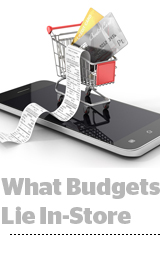
Shopper marketing, a longtime favorite of CPGs typically used for in-store signage or to get products on eye-level shelves, is undergoing a massive transformation thanks to the spread of ecommerce and online shops.
Of the $178 billion marketers spend annually on in-store marketing, $55 billion could shift from traditional retail trade marketing to online ads, according to the US Grocer Site Monetization report released this month by Gartner’s L2 market research group.
Some of this activity is driven by availability, as retailers like Walmart, Target and Kroger’s have launched programmatic ad platforms so brands carried by the stores can target known shoppers as well as drive and attribute in-store sales.
And it’s working. Kellogg’s is investing more of its shopper marketing in retailer-owned ad platforms, programmatic and social media, said Gail Horwood, senior VP of global marketing.
Retail ad platforms have an especially strong shopper marketing pitch because brands typically assign shopper marketers to a specific retailer, said Nishat Mehta, president of media at the retail advertising and data consultancy IRI.
A brand shopper marketer assigned to, say, Kroger or Target could spend on that respective retailer’s platform and feel confident the target audience will end up shopping at that chain and not with some other grocer where he or she doesn’t get credit.
The men’s grooming company Harry’s started exclusively as a direct-to-consumer ecommerce business, but its store distribution deal with Target “reshaped our marketing program,” a brand manager told AdExchanger last year, because it was more cost-effective to drive foot traffic to stores than get online users through an expensive customer acquisition funnel.
Amazon’s power
Retail ad platforms don’t have the targeting or breadth of audiences needed for branding or national marketing campaigns.
The CPG brand Del Monte distinguishes its national programmatic media campaigns from campaigns on retailer ad platforms, said Jen Reiner, senior director of omnichannel marketing and ecommerce.
Walmart and Target have comparable targeting and analytics to commercial DSPs, she said, but retailers don’t allow their online audiences to be tagged and measured like open programmatic campaigns. Del Monte’s national marketing team, for instance, couldn’t include retail platform audiences in frequency-capping efforts.
With more transparency or data reciprocity, “I could see brand teams willing to invest more in retailer networks,” Reiner said.
The exception is Amazon, the runaway leader in online shopper marketing as omnichannel brands start to think of ecommerce sellers as just another shelf. Many companies now pay Amazon an additional premium to operate branded storefronts on its site, a classic shopper marketing tactic applied online.
A Clorox brand manager told AdExchanger last year the company was investing heavily with Amazon because it’s the only place on the US internet “where someone scrolling through a product feed might actually see a product, click and then be a subscriber.”
Amazon’s sales data is also stronger than legacy retailers’, since its nearly 100% signed-in audience exposes credit or debit card data on every sale while retailers rely on loyalty program shoppers and an ecosystem of aggregated data to attribute sales.
The ecosystem of transaction and loyalty card data can be unreliable, Horwood said, because “there are significant fragmentation and availability issues within data sources.”
Del Monte faces the same fragmentation, with its store attribution data assembled through retailer deals to measure ad platform performance, Oracle Data Cloud, IRI, Nielsen data services like Nielsen Catalina Solutions and modeled data to fill in the picture for retailers without loyalty programs, Reiner said.
App-ily ever after
Other app-based ecommerce players with targetable data are getting in on the action too.
The cash-back app Ibotta, for example, licenses its store transactions and foot traffic data to CPG brands to run programmatic campaign attribution.
Brands have partnered with retailers on addressable coupon circulars for decades, so digital coupons and deal-based shopping services are a natural transition for Kellogg’s shopper budgets, Horwood said.
Shopper marketing “is actually a highly experimental category right now,” said Pehr Luedtke, senior VP of Valassis Digital. Many brands are testing chat bots to drive affiliate commerce from social media, mobile apps and SMS texts, he said, which is often a shopper marketing initiative.
Shopping rewards and cashback apps like Shopkick or RetailMeNot, a sister company to Valassis, are among the handful of apps people open in stores, Luedtke said, enabling location-based targeting and getting closer to that last-mile shopper marketing sweet spot.
This post was syndicated from Ad Exchanger.

More Stories
EXCLUSIVE: Most Americans Don’t Care If TikTok Shuts Down
Trump Grants TikTok a Second 75-Day Extension, Pushing Deadline to Mid-June
Reinventing Retail for Gen Z: Stacy Doren’s Vision for Journeys